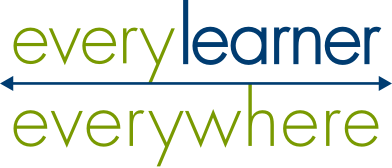Black, Latino, Indigenous, and poverty-affected college students are often presented with curricula designed for majority white students from middle- and upper-class backgrounds. Far from being neutral or “colorblind,” this can reinforce structural inequities. Culturally responsive teaching in higher education attempts to confront and remove equity gaps by viewing the cultural knowledge of students as an asset and then scaffolding that knowledge to the concepts being taught.
Making teaching relevant and engaging
“When education isn’t relevant, it’s hard to grab on to,” says Ruanda Garth-McCullough, Associate Director of Teaching and Learning at Achieving the Dream. “Culturally responsive teaching charges college educators to make what they’re teaching relevant to the students.”
Garth-McCullough is also one of the co-authors of The Caring for Students Playbook, developed by Every Learner Everywhere, The Online Learning Consortium, and Achieving the Dream, which emphasizes culturally responsive teaching as a practice that centers student care.
Culturally responsive teaching is more than engaging students with pop culture references, of course, but doing that much at least “is just good teaching,” says Garth-McCullough. “You should know who the students are that you’re serving. You should analyze your curriculum to see if what you’re teaching reflects who you’re teaching. Whose voices are you privileging?”
As a starting point, Garth-McCullough suggests instructors review the readings and assignments on the syllabus, analyze the gender, class, and race of the authors, and then ask whose voices are being privileged. What implicit statements is the syllabus making about what cultural knowledge is valued, or is “correct”?
Related reading — Bringing Trauma-Informed Teaching Into the Online College Classroom
Culturally responsive teaching gets below the surface
Garth-McCullough says a good outline of this subject is Zaretta Hammond’s 2014 book, Culturally Responsive Teaching and the Brain. Though primarily about K-12 education and cognitive development, the three “levels” of culturally responsive teaching that Hammond describes provides a useful framework for college and university faculty:
- Surface — observable and concrete elements of culture, such as food and music
- Shallow — cultural norms and attitudes, communication styles, nonverbal cues
- Deep — tacit cultural knowledge, worldview, guiding ethics
Each of these levels of culture informs how students learn. For example, at a surface level, students will connect differently to the voices and examples that appear in the curriculum.
Meanwhile, culturally responsive teaching working at a deep level understands that students from different cultures will respond differently to competitive work environments or to projects that emphasize individual effort versus collective knowledge.
In a blog post for Achieving the Dream, Garth-McCullough and her colleague Richard Sebastian outline eight competencies for culturally responsive teaching:
- Recognize and redress bias in the system.
- Draw on students’ culture to shape curriculum and instruction.
- Bring real-world issues into the classroom.
- Model high expectations for all students.
- Promote respect for student differences.
- Collaborate with families and the local community.
- Communicate in linguistically and culturally responsive ways.
- Reflect on one’s cultural lens.
Closing equity gaps with culturally responsive pedagogy
Instructors who want to truly engage students need to be aware of how minoritized and poverty-affected students in particular may experience the curriculum, course policies, and classroom dynamics, says Garth-McCullough: “Too often we give students the message to check all your cultural information at the door — your beliefs, your ways of being — so we can transform you in this ‘academic’ way.”
But when ethnically or racially minoritized students are essentially asked to start from scratch in the classroom, it only exacerbates the disparities that already exist in the educational system.
Oftentimes, before making sure a diversity of voices is represented, instructors first need to ensure texts and other course materials aren’t actively hostile toward minoritized students. For example, the State University of New York surveyed a criminal justice course and found the main textbook almost exclusively showed images of Black and Brown males as the criminals. They used a grant from Achieving the Dream (ATD) to create a new open-access text that didn’t perpetuate harmful stereotypes and that was more representative of U.S. crime statistics.
Culturally responsive teaching across the institution
Reaching students from many cultural backgrounds is a skill faculty are hungry for, notes Garth-McCullough, citing the popularity of the culturally responsive teaching track at ATD’s most recent Teaching and Learning Summit. ATD also offers equity webinars online and workshops at community college campuses.
A lot of this is individual work, with faculty identifying their own role in shutting out some student experiences. However, when culturally responsive teaching is treated as an individual preference for college instructors, it’s hard to get institution-wide traction.
“I think where most institutions struggle is in making faculty development in this area optional,” says Garth-McCullough. She points to several colleges that are making culturally responsive teaching an institutional priority:
- Community College of Baltimore County has educated over 1,500 of their instructors and staff about culturally responsive teaching in their center for teaching and learning. They also offer train-the-trainer courses and put on conferences on the subject.
- Columbus State Community College in Ohio offers a Global Diversity and Inclusion Certificate through courses on microaggressions, diversity, and implicit bias.
- Community College of Aurora in Colorado offers multiple classes and workshops for instructors designed to confront equity gaps that impact degree completion.
“We lose ground when training is optional,” says Garth-McCullough. “I would love to see a time when this is as important as training on how to log in to Blackboard.”
Culturally responsive teaching reaches students, wherever they are
This work can make college and university educators feel vulnerable, especially when they aren’t used to talking about structural inequities. The key is to focus on centering the student’s needs and identifying the shortfalls of the existing curriculum, rather than putting the blame on students for not being “college ready.”
Writing for the Faculty Focus blog, Gwen Bass and Michael Lawrence-Riddell emphasize that culturally responsive teaching has a lot in common with inclusive course design. Both concepts are about “making space for all learners” by “providing multiple means of representation, expression, and engagement.”
While creating a culturally responsive classroom is a journey rather than something that will happen during a single semester, Garth-McCullough recommends starting by making the invitation to ethnically and racially minoritized students intentional and explicit. “They need to know that their cultural knowledge is welcomed, seen as an asset, and valued in this academic space.”
By centering student cultural knowledge as part of a university’s strategic plan and investing in faculty training, colleges and universities can begin to make progress toward culturally responsive teaching.
Download Caring for Students Playbook: Six Recommendations
Originally published September 2020. Updated September 2021 with additional information and references.



